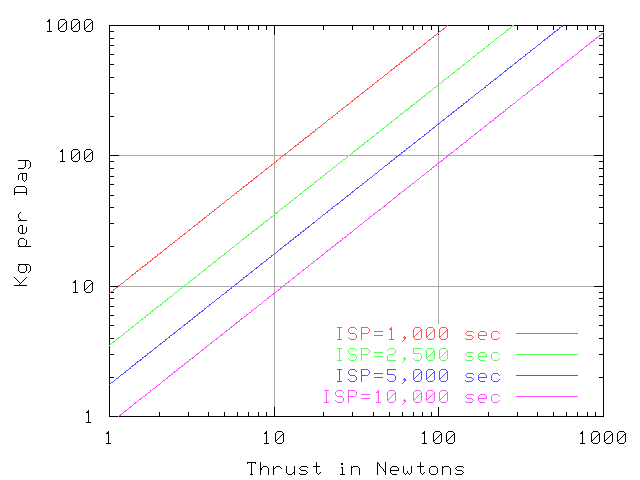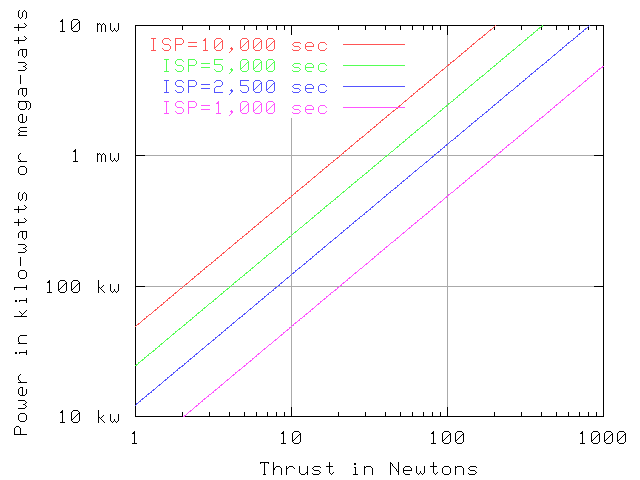
The next graph shows how higher ISP thrusters require more power. This is theoretical power, real electric thrusters will need something more than this depending on their efficiency.
We will use some method to add energy to the ballast that takes less fuel for the amount of thrust needed than a normal chemical rocket.
The following sections discuss methods of adding momentum to the ballast.
If we have a series of tethers going all the way to the moon (either 2 or 3 tethers) we could get two-way traffic by sending regolith back to Earth. The regolith has a lot of potential energy because it is higher in the Earth's gravity well. If we could sell the regolith once it is on Earth, that would be a bonus.
The trade-off is that electric propulsion systems take a lot of power but have low total thrust. They need longer time periods than chemical rockets. The power can be provided by solar panels almost 15 hours per day. With enough solar panels, power is not a problem. The mass of the solar panels will count as part of the ballast mass, so weight is not an issue.
One issue is that in LEO the Earth blocks the Sun part of the time. At 500 km altitude, a satellite will have at least 62% sunlight. At 6400 km altitude, an orbit sees sunlight at least 83% of the time.
The following graph shows how higher ISP thrusters use less reaction mass each day.

The next graph shows how higher ISP thrusters require more power.
This is theoretical power, real electric thrusters will need
something more than this depending on their efficiency.

Theoretically a thruster with twice the ISP uses about half the mass but with 4 times the energy for each gram. This combination requires about 2 times the energy for the same total thrust. Actual drives will have different efficiencies, so this will not hold exactly. A designer may use different thrusters depending on cost, how limited energy is, and other factors.
The drives can be small enough that having several of them for redundancy is not a problem. Ion Drives are an established, flight tested, and reliable technology.
If you combine 8 of these thrusters, you get about 4 newtons of thrust. You need 64 kw of electric power. As will be discussed later, this can modify the orbit of a four-ton payload in about two days. For a mass of 160 Kg plus 36 Kg of reaction mass you can transfer this payload from one end of the tether to the other. The net payload is 3,804 Kg.
Another product is the Boeing 702 Thruster. This has an ISP of 3800 seconds, requires 4.5 kw, and provides a thrust of 0.165 N. This used to be a Hughes product.
A Laboratory Model 50 Kw Hall Thruster provided up to 2.9 newtons and ISP from 1750 to 3250 seconds.
The Aerojet company has ion drives and hall thrusters.
The Russian made SPT-290 has up to 1.5 Newtons of thrust, weighs 23 Kg, and uses 5 to 30 kw of power. It is rated at 27,000 hours. This Russian unit has more thrust than any American unit we have found. The Russians have been building and flying these thrusters longer than Americans. The Russian labor costs are far below American costs, so the Russian sales prices are lower too. It seems like there are more companies in Russia making these types of thrusters than in the USA. A company outside the USA can have export control problems buying high tech equipment from inside the USA, but would not have such troubles buying from a Russian supplier. So there are many advantages to using a Russian supplier for thrusters.
An Electrodynamic Tether (EDT) uses a current through a long aluminum wire to push on the Earth's magnetic field. This is a simple motor; it requires a DC power supply, a conducting wire, and some way to contact the ionosphere to use it as the return path for the circuit. The reaction is a push on the tether in the direction of its orbit. This push can make up for momentum lost when the tether picks up a payload. An EDT is attractive because it does not use any propellant at all. We would still want some other thrusters for directional control even if this was the main thrust source. This technology seems reasonably well understood, but it has not been used yet to provide thrust in space. There is still some development, risk and testing for this technology.
The thrust is altitude dependent. Since the Earth's magnetic field drops off as the inverse of the cube of the radius, the motor gets less effective at higher altitudes. For a given power input the thrust will be less than half at 1500 km the thrust at 500 km altitude.
We can start out with some off the shelf thrusters and add in newer high-tech thrusters as they become available. There is no requirement that they all be the same type. This can provide a test platform for new thrusters. If the new thrusters fail, we continue with the older thrusters. An experiment does not risk the tether. Over time we can expect to reduce the amount of propellant used or possibly eliminate propellant with EDT and two-way traffic.
| Mass | Velocity | Momentum |
| 1000 Kg payload | 2,500 meters/sec | 2,500,000 Kg-meters/sec |
| 4000 Kg payload | 4,000 meters/sec | 16,000,000 Kg-meters/sec |
| 25 Kg xenon | 100,000 meters/sec | 2,500,000 Kg-meters/sec |
Next are some examples showing how much thrust it takes to get momentums comparable to those above in a day or two.
| Thrust level | Time thrusting | Momentum |
| 50 Newtons | 86,400 seconds (1 day) | 4,320,000 Kg-meters/sec |
| 10 Newtons | 172,800 seconds (2 days) | 1,728,000 Kg-meters/sec |
After a tether pickup the far side of the tether/ballast orbit is lower. To replace the momentum you need to thrust on the same side of the orbit that you picked up on. This means that you can only thrust like half the time. So to get the same momentum the above thrust numbers need to be doubled. This really is not such a bad thing as you only have sun on one side of the Earth when in LEO. Sunlight is needed to power solar cells used in EDTs or electric thrusters.
The faster you can replace the momentum given to one payload,
the sooner you can pick up another payload. So the more
thrust (or two-way-traffic) you have the better.
Click for SpaceTethers.com
Copyright (c) 2002, 2003 by Vincent Cate. All rights reserved.